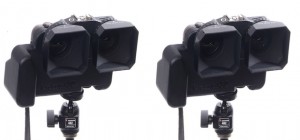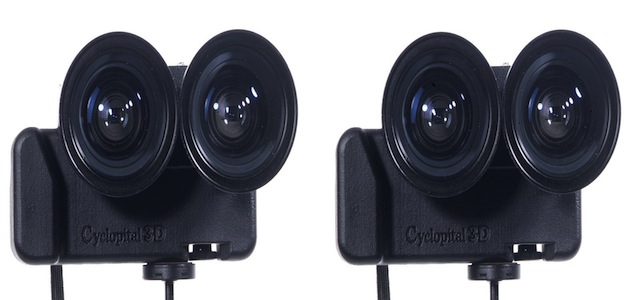The Cyclopital 3D Fujifilm W3 3D Camera Auxiliary Lens Adapter (ALA)
Cycloptial 3D ( www.cyclopital3d.com ) has recently introduced two very interesting adapters for the Fuji W3 3D camera (by the time this is published there should also be a third adapter, and all three are also supposed to become available for the Fuji W1 3D camera).
First is a Close-Up/Macro adapter. Second is an Auxiliary Lens Adapter.
As the Close-up adapter will be covered separately, I will report on using the Auxiliary Lens Adapter.
To use the adapter one simply opens up the W3 camera cover, so that it is turned on, and then fits the camera into the back of the adapter, securing it using a tripod screw, that is part of the unit.
Once fitted the adapter (see photo) expands the capabilities of the camera in several very useful ways.
First, and most important, it has 37mm filter threads in front of the camera’s lenses, so that filters, lens shades, and supplementary lenses (such as fisheye, wide angle, and telephoto) may be used on the camera.
Second, a flash slave trigger is incorporated into the body of the adapter, allowing use of the hot-shoe on top of the adapter with many flash units. A PC connector is also incorporated for use with flash units that use a PC cord.
Third, an ergonomic hand grip allows much easier and secure hand holding of the camera.
Fourth, a bubble level, visible from the top or back of the adapter is included,
Fifth, a standard thread tripod socket is located on the bottom of the unit, so a tripod may be used in conjunction with the adapter.
Last, it incorporates neck strap posts at either end, so that the camera may be worn like a traditional camera.
The entire unit weighs just a little more than 7 ounces (210 grams), so it does not add a lot of weight to the camera.
While it’s nice to have all of these features, the two that will probably interest most people are the filter threads and the flash hot shoe.
We already had a pair of Series 7 threaded supplemental Itorex semi-fisheye lenses. We had bought these around 1990 by mail order from one of the New York camera dealers, for use on a twinned Yashica (and later the RBT) 35mm stereo cameras. For those we had 49mm and 52mm adapters. So, first I had to obtain a pair of 37mm to Series 7 step-up rings to attach the lenses to the adapter.
Once I had the step-up rings the fisheye lenses fit perfectly on the adapter. (Smaller 37mm lens supplements are available, but we already owned these, and they seem to be very nice quality).
At the widest angle of the cameras lenses I did not get a full fisheye, but very close. One can use the zoom feature to get varying degrees of wide angle images. See accompanying photos for examples.
As the fisheye lenses are supplemental lenses, not prime lenses, I recall that on our 35mm cameras we had to use f/11 or smaller to get really sharp slides. On my W3 tests I did not bother with this, and shot under a variety of conditions, both with, and without, flash (using the hot shoe on the adapter!). The pictures looked sharp on the camera display, but I did not expect them to be as sharp on a 22″ monitor. Much to my surprise, they held up well, and appear sharp, even at apertures larger than f/11. I can’t explain it, but I can see the results.
Ken Burgess of Cyclopital 3D recommends the Raynox 0.5x wide-angle lenses (about $120 each from B&H in NY, so not a cheap way to go wide angle. Dr. T says he has been happy with a par of fisheye lens supplemets made by Opteka for about $30 each, and a Digital concepts 37mm Tele/Wide lens combo for $17 each (so for for about $34 you get 2 wide angle and 2 telephoto lenses that will fit the ALA. Google to find these, as Dr. T did not give the source.
I mentioned using the flash with the hot shoe. I have to say that I tried 3 different flashes until I got one that worked, a trusty Vivitar 283. Cyclopital states that because no batteries are used in the slave trigger, it does not work with ALL flashes, but will work with most. They have a link to a list of known compatible and incompatible flash units.
For my first flash shot I tried full automatic. Way overexposed. Then I tried using the recommended starting place settings suggested by Cyclopital’s instruction manual. “Set the camera in manual mode, use menu to set shutter speed to 1/60th second. We recommend setting the aperture to F9 and the ISO to 100.” This happened to work perfectly, with the Vivitar set to the BLUE range of the auto setting (which was the one I used to use with Kodachrome 64 most of the time). Also, being digital, with instant viewing, one can easily make small adjustments to the camera or flash settings to optimize the exposure.
When not using the fisheye lenses, or supplemental flash, or both at the same time, the adapter is useful to have your camera ready for a serious day of shooting by being able to wear it around your neck, like a traditional (pre-digital) camera. Add a pair of 37mm lens shades and it looks and feels more substantial, and just might be a bit less prone to lens flare as well.
For those of you who already own a W3 or W1 camera, you may be asking how to turn the camera on and off while the camera is fitted into the adapter, since the sliding cover (which also acts as the on/off switch) is no longer accessible.
The camera will turn itself off after an interval of non-use (adjustable in the camera menu). However, it can also be manually turned off by holding down the play button. First the camera will enter playback mode. Pressing and holding the play button will then turn the camera off.
When the camera is off, pressing and holding the play button turns the camera on, in playback mode. Then briefly pressing the shutter button changes the mode to shooting mode. This solves the on/off problem.
Once last feature on the adapter that I noticed is that there is a brass threaded screw hole centered between the 37mm filter rings on the front face of the adapter. I wrote to Ken and Tanya at Cyclopital to ask what this was for. This is for a future accessory that is mentioned on their web page as an “optional polarizer attachment”. This is not available yet, but a photo they sent me shows a 3 polarizer arrangement (one for each lens, and the third for viewing) which all rotate in unison. This will attach via this mystery screw hole.
These adapters are made in small batches, with a lot of hand labor involved in the final finishing of each unit. Price is US$249.95, including shipping.
Not cheap, but not bad for such a specialized unit that significantly extends the capabilities of the Fuji W3 and W1 cameras. We felt it was well worth the price for all the added benifits it adds to the camera.

For more information, and to order, see www.cyclopital3d.com

Great review, great blog. Thank you so much.
Thanks for the excellent (and complete!) review, David! You answered all my questions without my having to ask them!
Cordially,
Oliver Dean
Hi, This was a fine intro to the cyclopital. I recently purchased two 2.2 super telephoto HD conversion lenses (HD-2200Pro) and after mounting them on the Cyclopital, one side vignetted the image. Seems that the distance between the two lenses does not exactly match the Cyclopital mount and one needs lenses with a wider coverage. In addition, this telephoto lense does not zoom and the full zoom of the camera lens is needed in order to get minimum vignetting. This lens is unsuitable for the 3DW3.
Can you recommend the different lenses which both offer zoom capabilities and are of fine quality. I have no interest in inferior lenses. Can’t find a site which recommends auxiliary lenses for this camera.
Would be nice if Cyclopital would offer a rear folding barn-door attachment such as was classic on the 4×5 Speed Graflexes. I can’t see a thing in the sunlight, and in any light it is difficult to adjust the brightness of the image towards the final image quality desired, using the exposure compensation for the correct mood of the image.
Looking forward to a post of the recommended lenses that are compatible to the Cyclopital. yosaif
Thanks for the awesome review! It helped me to make the decision to pony up the $249 to get one. I, also, purchased a new in box vivitar 283 from eBay. The lack of external flash has been the most frustrating part of using the W3. The second being the inability to use a shoulder strap. Thanks again.
Well, the Vivitar 283 flash that I bought didn’t work with the adapter, but my Neewer Model: SF-01 works like a charm in normal mode. I had bought it to use with the W3 as a slave flash, but hated how it got fired from other people’s flashes, making it almost useless. I should have waited til I got my adapter in, but no problem, as I will put the Vivitar 283 back on eBay. Oh yeah, manual mode 1/60 sec and f5 for the Neewer Model: SF-01 works great!
Oh yeah, manual mode 1/60 sec and f5 for the Neewer Model: SF-01 works great!
It’s me again. I just wanted to let people know that apparently the Wein Safe Sync allows me to fire my vintage Vivitar 283 flash unit from the adapter. I had bought a few years ago when I was first shooting digital 3d with studio lights. I had heard that there was a possibility of burning out the electronics from the high voltage that some studio lights had. So, when I remembered this, I tried it out and it works like a charm. I, also, tried it without the safe sync to make sure that it wouldn’t fire that way, and sure enough it wouldn’t fire. My solution probably won’t work for all flashes like the Sony HVL-F32X since it is a proprietary flash, but I’m guessing it will work with most universal flash units.